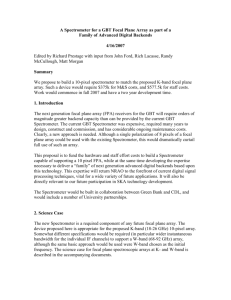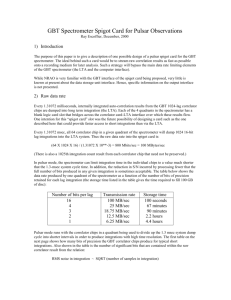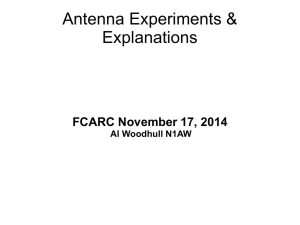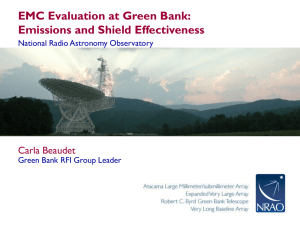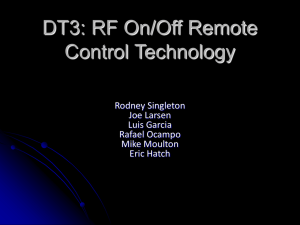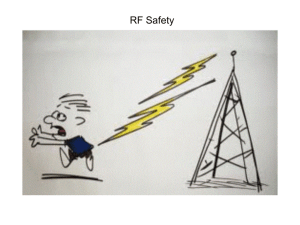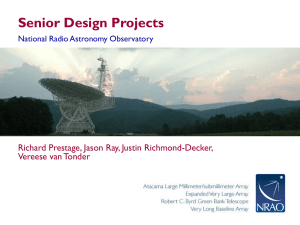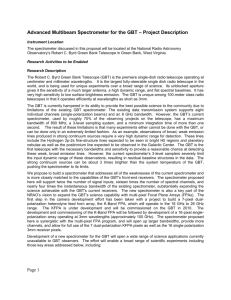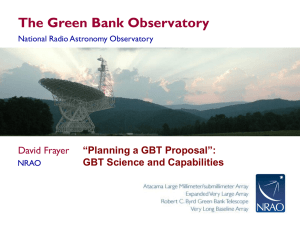gbtSpec_v4_ford_werthimer_ursi
advertisement
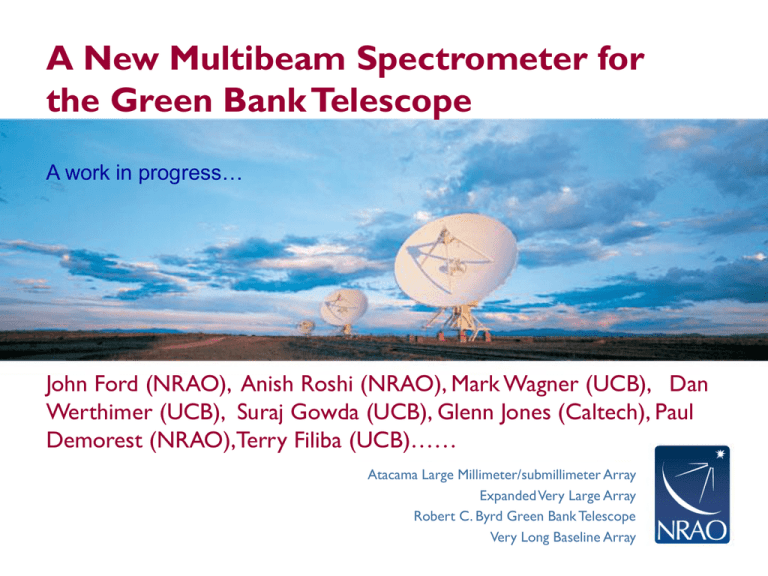
A New Multibeam Spectrometer for
the Green Bank Telescope
A work in progress…
John Ford (NRAO), Anish Roshi (NRAO), Mark Wagner (UCB), Dan
Werthimer (UCB), Suraj Gowda (UCB), Glenn Jones (Caltech), Paul
Demorest (NRAO),Terry Filiba (UCB)……
Atacama Large Millimeter/submillimeter Array
Expanded Very Large Array
Robert C. Byrd Green Bank Telescope
Very Long Baseline Array
Molecules and Comets
Molecular emission maps of comet HaleBopp made in HCN (left) and HCO+ (right)
with the 14 m telescope of the FCRAO,
whose angular resolution is about the size of
the cross in the right panel. Overlaid dots
show the footprint of a 16-pixel GBT array in
these lines. Figure courtesy A.J. Lovell.
Eight new biologically significant
molecules were discovered in the
interstellar medium in a two-year
period using the GBT.
2
Pulsars at the Galactic Center ??
100’s of pulsars predicted in the central pc
none undiscovered - Macquart, Frail, Ransom, Bower..
Map gravitational field (timing), ISM at GC,
black hole spin?
Extreme scattering smears out the pulse
High Frequency Observation to minimize scattering
High Bandwidth Needed at High Frequency (low flux)
800 MHz 8 GHz
3
Why a New Spectrometer?
New Spectrometer
Old GBT Spectrometer
Polyphase Filter Bank for RFI rejection
Autocorrelation Spectrometer
256 level samplers
3 level samplers
16 high-speed samplers
8 high-speed samplers
1350 MHz bandwidth/sampler
800 MHz bandwidth/sampler
800 MB/s max disk I/O rate
< 25 MB/s max disk I/O rate
New technology (FPGA based, Virtex-{5,6}
Designed and built in early 1990’s
4
5
6
7
8
Specification Development -- Inputs
• Spectrometer IF Inputs
– 16 IF inputs
• Matched to the GBT Focal Plane Array pilot programs of 16 IFs
per instrument
• Usable with the existing GBT IF system
– 150 to 1500 MHz input bandwidth
• Allows coverage of extragalactic line observations up to ~3000
km/s at 90 GHz
• 150 MHz is the low frequency cutoff in GBT IF system
• 1500 MHz is the Nyquist frequency for 3 GHz sampling rate
– Isolation
• GBT low frequency feeds have polarization isolation of more than
35 dB, so we specify more than 35 dB isolation, and stability of
one hour to allow for calibration
9
Specification Development -- Outputs
• Support for frequency-switched and position-switched observations, and
pulsed cal signals.
– Up to 6 switching states will be available
– Controlled by the spectrometer or by an external switching master
– Minimum switching state width of 25 milliseconds
• Full-Stokes available if required for polarization studies
• Modest pulsar capabilities
– ~ 4096 channels, dumped at a maximum rate of 500 microseconds
– Full-Stokes
• Maximum disk output of 100 MB/sec per IF pair, full Stokes
10
Specification Development – Processing
• High-resolution modes
– OH Maser Observations
• Require about 100 km/s range, and about 0.01 km/s resolution
• 1 MHz bandwidth
• 32,768 channels
– Extragalactic H2O Maser Observations
• Require about 5000 km/s range and about 0.3 km/s resolution
– 370 MHz of bandwidth
– 16,384 channels
• Wide-bandwidth modes
– Extragalactic spectral line observations of, e.g. 12CO
• Require about 3000 km/s range and about 5 km/s resolution
– 900 MHz bandwidth, 1024 channels
11
Specification Development -- Processing
• Multiple Spectral Windows
– For many observations, several narrow lines are separated across the
bandpass by large expanse of uninteresting or RFI infested spectrum.
– Recombination line transitions in the 342 MHz band
– Multiple NH3 transitions at ~22 GHz
– Requires ~8 sub-bands to cover these
– Bandwidth
• Recombination lines require about 500 km/s range and about 0.5
km/s
– Requires about 1 MHz and 2048 channels
• NH3 requires about 100 km/s range and 0.04 km/s resolution
– Requires about 14 MHz and 4096 channels
12
Summary of Required Observing Modes
13
14
Overall Block Diagram
15
Roach Motel (Roach Nest) (KAT)
Polyphase Filter Bank
Current CASPER ADC Boards
ADC2x1000-8 (dual 1GSa/sec, single 2Gsps, 8 bit)
ADC1x3000-8 (3GSa/sec, 8 bit) ADC (6Gsps interleaved)
64ADCx64-12 (64x 64MSa/sec, 12 bit)
ADC4x250-8 (quad 250MSa/sec, 8 bit)
katADC (dual 1.5GSa/sec, 8 bit, with gain, atten, synth)
ADC2x550-12 (dual 550 Msps, 12 bit)
ADC2x400-14 (dual 400 Msps, 14 bit)
ADC1x5000-8 (1x5Gsps,2x2.5Gsps,4x1.25G sps – Taiwan)
ADC1x1000-12 (optically isolated 12 bit 1Gsps – JPL)
Upcoming Hardware
• Roach II (Virtex 6 – South Africa team)
• Rhino (Spartan 6, ARM CPU, FMC connect)
• Roach III ? (Virtex 7)
• 20 to 26 Gsps ADC board
Preliminary Design Work
• Concentrating on the hard parts
– 3 GS/s sampling and PFB/FFT calculations
– Heterogeneous Computing Approach
• Divide processing into front/back ends
• Use FPGAs to fully process bandwidths greater than 200 MHz
• Use FPGA front-ends to pre-process, split and packetize data,
then GPUs to provide fine channelization on narrower chunks
– Software Design
• Adapting concepts and code from the Green Bank Ultimate Pulsar
Processing Instrument (GUPPI)
• Adding support for the K-band FPA processing pipeline
• Integrating with the GBT Monitor and Control System for user
ease.
21
Preliminary Design Work
• Developing support hardware
– IF system interface
• Anti-alias low-pass filters
• Noise/test signal injection
• Amplification
– Analog to Digital Converter sampling clock generation/distribution
– 1 Pulse Per Second distribution
– Packaging
22
